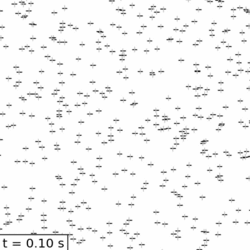Lamb–Oseen vortex
In fluid dynamics, the Lamb–Oseen vortex models a line vortex that decays due to viscosity. This vortex is named after Horace Lamb and Carl Wilhelm Oseen.[1][2]
Mathematical description
Oseen looked for a solution for the Navier–Stokes equations in cylindrical coordinates [math]\displaystyle{ (r,\theta,z) }[/math] with velocity components [math]\displaystyle{ (v_r,v_\theta,v_z) }[/math] of the form
- [math]\displaystyle{ v_r=0, \quad v_\theta=\frac{\Gamma}{2\pi r}g(r,t), \quad v_z=0. }[/math]
where [math]\displaystyle{ \Gamma }[/math] is the circulation of the vortex core. Navier-Stokes equations lead to
- [math]\displaystyle{ \frac{\partial g}{\partial t} = \nu\left(\frac{\partial^2 g}{\partial r^2} - \frac{1}{r} \frac{\partial g}{\partial r}\right) }[/math]
which, subject to the conditions that it is regular at [math]\displaystyle{ r=0 }[/math] and becomes unity as [math]\displaystyle{ r\rightarrow\infty }[/math], leads to[3]
- [math]\displaystyle{ g(r,t) = 1-\mathrm{e}^{-r^2/4\nu t}, }[/math]
where [math]\displaystyle{ \nu }[/math] is the kinematic viscosity of the fluid. At [math]\displaystyle{ t=0 }[/math], we have a potential vortex with concentrated vorticity at the [math]\displaystyle{ z }[/math] axis; and this vorticity diffuses away as time passes.
The only non-zero vorticity component is in the [math]\displaystyle{ z }[/math] direction, given by
- [math]\displaystyle{ \omega_z(r,t) = \frac{\Gamma}{4\pi \nu t} \mathrm{e}^{-r^2/4\nu t}. }[/math]
The pressure field simply ensures the vortex rotates in the circumferential direction, providing the centripetal force
- [math]\displaystyle{ {\partial p \over \partial r} = \rho {v^2 \over r}, }[/math]
where ρ is the constant density[4]
Generalized Oseen vortex
The generalized Oseen vortex may be obtained by looking for solutions of the form
- [math]\displaystyle{ v_r=-\gamma(t) r, \quad v_\theta= \frac{\Gamma}{2\pi r}g(r,t), \quad v_z = 2\gamma(t) z }[/math]
that leads to the equation
- [math]\displaystyle{ \frac{\partial g}{\partial t} -\gamma r\frac{\partial g}{\partial r} = \nu \left(\frac{\partial^2 g}{\partial r^2} - \frac{1}{r} \frac{\partial g}{\partial r}\right). }[/math]
Self-similar solution exists for the coordinate [math]\displaystyle{ \eta=r/\varphi(t) }[/math], provided [math]\displaystyle{ \varphi\varphi' +\gamma \varphi^2=a }[/math], where [math]\displaystyle{ a }[/math] is a constant, in which case [math]\displaystyle{ g=1-\mathrm{e}^{-a\eta^2/2\nu} }[/math]. The solution for [math]\displaystyle{ \varphi(t) }[/math] may be written according to Rott (1958)[5] as
- [math]\displaystyle{ \varphi^2= 2a\exp\left(-2\int_0^t\gamma(s)\,\mathrm{d} s\right)\int_c^t\exp\left(2\int_0^u \gamma(s)\,\mathrm{d} s\right)\,\mathrm{d}u, }[/math]
where [math]\displaystyle{ c }[/math] is an arbitrary constant. For [math]\displaystyle{ \gamma=0 }[/math], the classical Lamb–Oseen vortex is recovered. The case [math]\displaystyle{ \gamma=k }[/math] corresponds to the axisymmetric stagnation point flow, where [math]\displaystyle{ k }[/math] is a constant. When [math]\displaystyle{ c=-\infty }[/math], [math]\displaystyle{ \varphi^2=a/k }[/math], a Burgers vortex is a obtained. For arbitrary [math]\displaystyle{ c }[/math], the solution becomes [math]\displaystyle{ \varphi^2=a(1+\beta \mathrm{e}^{-2kt})/k }[/math], where [math]\displaystyle{ \beta }[/math] is an arbitrary constant. As [math]\displaystyle{ t\rightarrow\infty }[/math], Burgers vortex is recovered.
See also
- The Rankine vortex and Kaufmann (Scully) vortex are common simplified approximations for a viscous vortex.
References
- ↑ Oseen, C. W. (1912). Uber die Wirbelbewegung in einer reibenden Flussigkeit. Ark. Mat. Astro. Fys., 7, 14–26.
- ↑ Saffman, P. G.; Ablowitz, Mark J.; J. Hinch, E.; Ockendon, J. R.; Olver, Peter J. (1992). Vortex dynamics. Cambridge: Cambridge University Press. ISBN 0-521-47739-5. p. 253.
- ↑ Drazin, P. G., & Riley, N. (2006). The Navier–Stokes equations: a classification of flows and exact solutions (No. 334). Cambridge University Press.
- ↑ G.K. Batchelor (1967). An Introduction to Fluid Dynamics. Cambridge University Press.
- ↑ Rott, N. (1958). On the viscous core of a line vortex. Zeitschrift für angewandte Mathematik und Physik ZAMP, 9(5-6), 543–553.
 |



